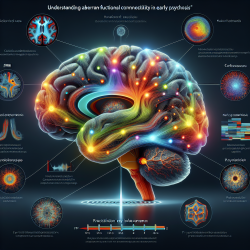Introduction
The realm of psychosis research has been invigorated by recent findings from a study titled "A whole-brain neuromark resting-state fMRI analysis of first-episode and early psychosis: Evidence of aberrant cortical-subcortical-cerebellar functional circuitry." This research provides critical insights into the brain's functional connectivity during the early stages of psychosis, offering practitioners valuable information to refine their therapeutic approaches.
Key Findings
The study employed a data-driven whole-brain approach using resting-state functional magnetic resonance imaging (rs-fMRI) to examine functional network connectivity (FNC) patterns in individuals with first-episode psychosis (FEP) and early psychosis (EP). The analysis revealed significant dysconnectivity in cortical, subcortical, and cerebellar regions, which are pivotal for cognitive functions. Notably, reduced cerebellar connectivity was highlighted, suggesting its potential role in psychosis, an area often overlooked in favor of cortical and subcortical regions.
Implications for Practitioners
For practitioners, these findings underscore the importance of early detection and intervention in psychosis. The study's identification of aberrant connectivity patterns provides a framework for understanding the neural mechanisms underlying psychosis, which can inform the development of targeted interventions.
Practitioners can enhance their therapeutic strategies by:
- Incorporating neuroimaging techniques, such as rs-fMRI, into early diagnostic processes to identify at-risk individuals through biological markers.
- Developing interventions that specifically target the identified dysconnectivity in cortical-subcortical-cerebellar circuits, potentially improving cognitive outcomes.
- Engaging in interdisciplinary collaboration with neuroscientists to translate these findings into practical therapeutic tools.
Encouraging Further Research
The study also highlights the need for further research into the functional abnormalities present at the onset of psychotic symptoms. By focusing on individuals in the earliest stages of psychosis, researchers can minimize confounding factors and better understand the neurobiological underpinnings of the disorder.
Practitioners are encouraged to participate in or support research initiatives that explore these early-stage abnormalities. Such involvement can lead to the development of more effective, evidence-based interventions that address the specific neural disruptions associated with psychosis.
Conclusion
The findings from this study offer a promising avenue for enhancing the early detection and treatment of psychosis. By leveraging the insights gained from neuromark analysis, practitioners can improve their diagnostic and therapeutic approaches, ultimately leading to better outcomes for individuals experiencing early psychosis.
To read the original research paper, please follow this link: A whole-brain neuromark resting-state fMRI analysis of first-episode and early psychosis: Evidence of aberrant cortical-subcortical-cerebellar functional circuitry.










